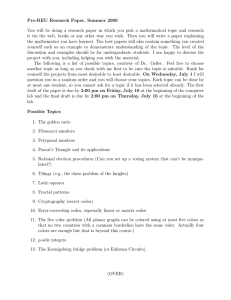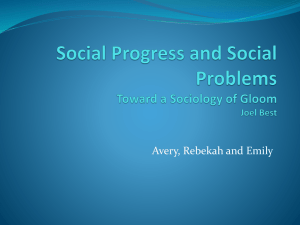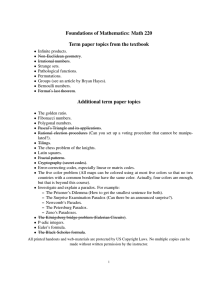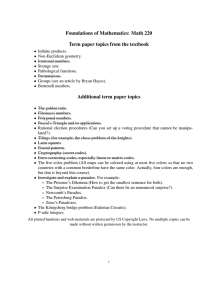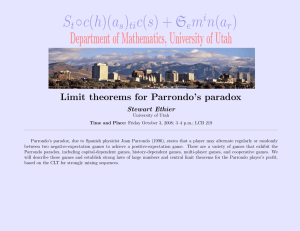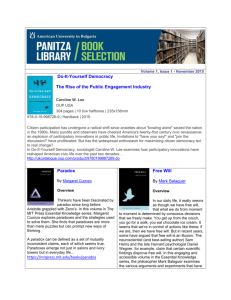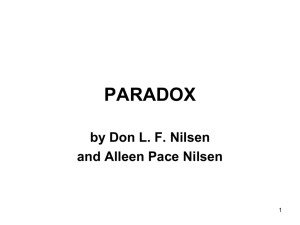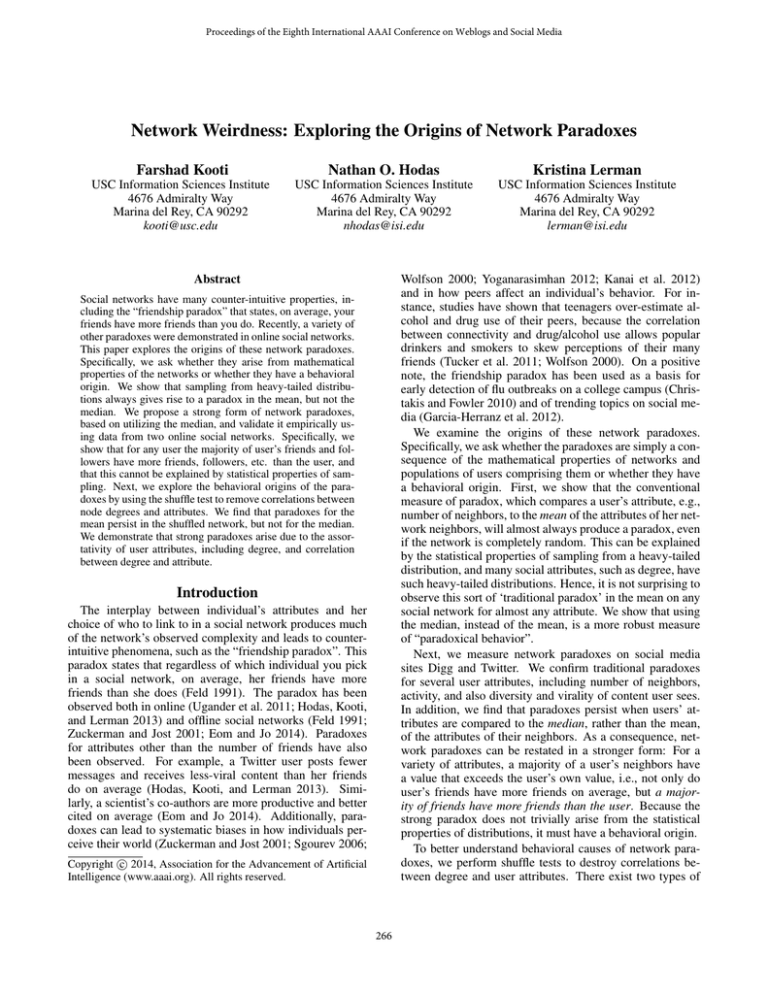
Proceedings of the Eighth International AAAI Conference on Weblogs and Social Media
Network Weirdness: Exploring the Origins of Network Paradoxes
Farshad Kooti
Nathan O. Hodas
Kristina Lerman
USC Information Sciences Institute
4676 Admiralty Way
Marina del Rey, CA 90292
kooti@usc.edu
USC Information Sciences Institute
4676 Admiralty Way
Marina del Rey, CA 90292
nhodas@isi.edu
USC Information Sciences Institute
4676 Admiralty Way
Marina del Rey, CA 90292
lerman@isi.edu
Abstract
Wolfson 2000; Yoganarasimhan 2012; Kanai et al. 2012)
and in how peers affect an individual’s behavior. For instance, studies have shown that teenagers over-estimate alcohol and drug use of their peers, because the correlation
between connectivity and drug/alcohol use allows popular
drinkers and smokers to skew perceptions of their many
friends (Tucker et al. 2011; Wolfson 2000). On a positive
note, the friendship paradox has been used as a basis for
early detection of flu outbreaks on a college campus (Christakis and Fowler 2010) and of trending topics on social media (Garcia-Herranz et al. 2012).
We examine the origins of these network paradoxes.
Specifically, we ask whether the paradoxes are simply a consequence of the mathematical properties of networks and
populations of users comprising them or whether they have
a behavioral origin. First, we show that the conventional
measure of paradox, which compares a user’s attribute, e.g.,
number of neighbors, to the mean of the attributes of her network neighbors, will almost always produce a paradox, even
if the network is completely random. This can be explained
by the statistical properties of sampling from a heavy-tailed
distribution, and many social attributes, such as degree, have
such heavy-tailed distributions. Hence, it is not surprising to
observe this sort of ‘traditional paradox’ in the mean on any
social network for almost any attribute. We show that using
the median, instead of the mean, is a more robust measure
of “paradoxical behavior”.
Next, we measure network paradoxes on social media
sites Digg and Twitter. We confirm traditional paradoxes
for several user attributes, including number of neighbors,
activity, and also diversity and virality of content user sees.
In addition, we find that paradoxes persist when users’ attributes are compared to the median, rather than the mean,
of the attributes of their neighbors. As a consequence, network paradoxes can be restated in a stronger form: For a
variety of attributes, a majority of a user’s neighbors have
a value that exceeds the user’s own value, i.e., not only do
user’s friends have more friends on average, but a majority of friends have more friends than the user. Because the
strong paradox does not trivially arise from the statistical
properties of distributions, it must have a behavioral origin.
To better understand behavioral causes of network paradoxes, we perform shuffle tests to destroy correlations between degree and user attributes. There exist two types of
Social networks have many counter-intuitive properties, including the “friendship paradox” that states, on average, your
friends have more friends than you do. Recently, a variety of
other paradoxes were demonstrated in online social networks.
This paper explores the origins of these network paradoxes.
Specifically, we ask whether they arise from mathematical
properties of the networks or whether they have a behavioral
origin. We show that sampling from heavy-tailed distributions always gives rise to a paradox in the mean, but not the
median. We propose a strong form of network paradoxes,
based on utilizing the median, and validate it empirically using data from two online social networks. Specifically, we
show that for any user the majority of user’s friends and followers have more friends, followers, etc. than the user, and
that this cannot be explained by statistical properties of sampling. Next, we explore the behavioral origins of the paradoxes by using the shuffle test to remove correlations between
node degrees and attributes. We find that paradoxes for the
mean persist in the shuffled network, but not for the median.
We demonstrate that strong paradoxes arise due to the assortativity of user attributes, including degree, and correlation
between degree and attribute.
Introduction
The interplay between individual’s attributes and her
choice of who to link to in a social network produces much
of the network’s observed complexity and leads to counterintuitive phenomena, such as the “friendship paradox”. This
paradox states that regardless of which individual you pick
in a social network, on average, her friends have more
friends than she does (Feld 1991). The paradox has been
observed both in online (Ugander et al. 2011; Hodas, Kooti,
and Lerman 2013) and offline social networks (Feld 1991;
Zuckerman and Jost 2001; Eom and Jo 2014). Paradoxes
for attributes other than the number of friends have also
been observed. For example, a Twitter user posts fewer
messages and receives less-viral content than her friends
do on average (Hodas, Kooti, and Lerman 2013). Similarly, a scientist’s co-authors are more productive and better
cited on average (Eom and Jo 2014). Additionally, paradoxes can lead to systematic biases in how individuals perceive their world (Zuckerman and Jost 2001; Sgourev 2006;
c 2014, Association for the Advancement of Artificial
Copyright Intelligence (www.aaai.org). All rights reserved.
266
3.5
3
Exp
Log−normal
Pareto
2.5
2
1.5
1 0
10
1
2
10
10
Sample Size
(a)
3
10
% Users In Paradox Condition
Estimated Mean / Median
correlations in social networks. First, there is a correlation
between attribute of a node, such as activity, and its degree
(within-node correlation). In addition, there is assortativity,
or correlation between the attributes of a node and the attributes of its neighbors (between-node correlation). Each
of these correlations might explain the paradoxes. To understand the exact origin, we separate the effect of different correlations by destroying one of the correlations while
keeping the other one, which is done using a controlled shuffle test. We find that both within-node and between-node
correlations are each responsible for the paradoxes.
Existence of the strong paradox for an attribute implies
that for most users, a randomly selected friend is likely to exceed the user in that attribute. Because the same behavioral
factors that create between-node correlations in attributes
and within-node correlations are often related to desirability of that attribute (extraversion, wealth, etc.), people end
up dynamically positioning themselves in the network to
remain subject to the strong paradox. The users will perceive themselves as inferior to friends, even if comparison
is done on a one-to-one basis. This may explain why selfassessments are negatively correlated with exposure to online social media (Kross et al. 2013; Chou and Edge 2012).
Our specific contributions are as follows:
0.9
0.8
Mean
Median
0.7
0.6
0.5
0.4 0
10
1
2
10
10
Number of Friends
3
10
(b)
Figure 1: (a) Estimated mean grows with sample size. Three
distributions, exponential (Exp), log-normal, and Pareto,
each result in different biased estimates of the mean. The
larger the difference between median and population mean,
the larger the discrepancy. Thus, a user will always observe
a paradox when calculating the mean of its neighbors when
the population mean is greater than the median. (b) Effect
of using mean vs. median on fraction of users with given
number of friends estimated to be in paradox condition in a
random network with no correlations. Users’ attributes are
drawn independently from ∼ x−1.2 .
have a behavioral origin. Conversely, a paradox using the
mean may arise simply from statistics of the attribute distribution, without any behavioral component or correlation
between users.
To be more precise, consider the definition of mean vs me1
dian for continuous,
R ∞non-negative distributions . The mean
is defined as µ ≡ 0 xP (x) dx. The median, m, is defined
Rm
by the solution to 12 = 0 P (x) dx. Given a sample consisting of a single random instance drawn from P (x), there
is an equal chance that it will be larger or smaller than m.
What value would you estimate that minimizes the mean absolute error with the mean of a sample with size = 1? This
is the median of the distribution, m (Lee 1995). At the other
extreme, the value that minimizes the absolute error with
the mean of an infinitely large sample is µ, by definition.
Social behavior is often characterized by unimodal distributions with heavy tails, so m ≤ µ. Thus, as the sample size
from a distribution increases, the observed mean of the sample increases monotonically from m to µ.
Figure 1(a) provides an illustration of this behavior. We
randomly sample values from three example distributions,
exponential (∼ e−2x ), log-normal (µ = −0.3, σ = 1.5),
and Pareto (∼ x−1.2 ), and calculate the mean and median
of the samples of varying sizes. The true mean and median for these distributions are (µ = 12 , m = 12 log 2),
(µ = 2.28, m = 0.74), and (µ = 6, m = 1.78), respectively. As explained above, the estimated sample mean
changes monotonically from m to µ as the sample size increases from 1, shown in Fig. 1(a). However, the sample
1. We characterize the differences between the traditional
(‘weak’) paradox, which is based on the mean, and our
strong paradox, based on the median. We empirically
demonstrate that previously observed paradoxes still hold
as strong paradoxes.
2. We show that upon shuffling the network, weak paradoxes
persist but the strong paradoxes are diminished or destroyed, demonstrating that the magnitude of strong paradox can be used as a measure of behavioral factors in the
creation and maintenance of the social network.
3. We also show that the observation of a weak paradox
does not imply any within-node or between-node correlation between attributes and connectivity; they can arise
in completely random networks devoid of correlation.
Our work suggests that network structure and node attributes in social media are intimately connected. Accounting for these often non-intuitive relationships is necessary
for understanding, modeling, and predicting individual and
social behavior in networks.
Statistical Origins of Paradoxes
The friendship paradox is thought to be rooted in the heterogeneous distribution of node attributes, such as node degree (Feld 1991). Such distributions are characterized by a
“heavy tail”, where extremely large values, e.g., high degree
nodes, appear much more frequently than expected compared to a normal or exponential distribution. These large
values skew the “average”, giving rise to a large difference
between the mean and the median. In this section, we show
that randomly sampling from a heavy-tailed distribution can
produce a paradox when using the mean, but not the median. Therefore, if the friendship paradox also exists in the
median, it cannot be purely statistical in nature, and must
1
The conclusions in the present work hold for any distribution
where the mean is greater than the median. This is almost always the case for heavy-tailed distributions, but may be violated
for small-support discrete distributions. When median > mean, the
present conclusions are simply reversed; we would expect ‘antiparadoxes’ when considering the mean.
267
For measuring other network paradoxes, we further restrict the network to users who joined Twitter before the beginning of the dataset. These are the users whose activity is
recorded over the entire observation period. This leaves us
with 29.4M tweets, with 2.2M users and 113M links.
In addition, we also use the Digg dataset presented
by (Sharara, Rand, and Getoor 2011). Digg is distinct from
Twitter because it is primarily a social news site. Despite
this, it is similar to Twitter in many ways. Digg users submit links to news stories they find online, which is similar
to posting a tweet. Other users vote for, or digg, these stories, which is similar to retweeting. Moreover, Digg allowed
users to follow submissions and diggs of other users, creating a friend-follower network similar to Twitter. However,
unlike Twitter, Digg promoted popular news stories to the
front page, where they could be seen by all Digg users. To
reduce potentially confounding factors, we focus only on
pre-promotion votes, when the stories were mainly visible
through the social network (Hodas and Lerman 2013).
The Digg dataset includes all diggs on news stories of
11.9K users submitted to Digg over a six months period of
July to December 2010. There are more than 1.9M diggs on
29K stories in the dataset, with 1.3M follow links.
For convenience, we refer to the people followed by a user
U as U ’s friends and those who follow her as U ’s followers.
Thus, U receives content from her friends in the form of
messages on Twitter or recommendations for news stories
on Digg, and sends content to her followers.
median does not vary with sample size, because half of the
numbers in the sample are below the population median and
half above. Thus, if you consider the fraction of users in
paradox condition, shown in Figure 1(b), when users attributes are drawn iid from the previous Pareto distribution,
the more friends a user has, the more likely the mean of their
friends’ attributes exceeds their own, but when using the median, no paradox is observed.
Thus, consider the following explanation of how network
paradoxes arise and how they depend on what you mean by
“average.” Assume we are measuring some empirical quantity — user attribute x — in a purely random network where
each user’s x is an independent, identically distributed (iid)
variable (and x is not node degree). The x for a user is compared to the “average” x for the user’s network neighbors.
The best estimate (with respect to mean absolute error) of x
for the user is mx , because it is a sample of size 1. On the
other hand, the number of users’ neighbors is at least one,
meaning that the best estimate for the mean of the neighbors’ x is ≥ mx . Therefore, even in a purely random network, as long as the mean of x is greater than the median of
x, one would be led to the conclusion that “your x is smaller
than the mean of your neighbors’ x.” But, if you consider
the median, both you and your neighbors will have the same
median, and no paradox will be observed. One may show
that in a fully-connected network, where attributes are iid,
the fraction of users in the strong paradox condition is no
larger than 0.5 + 1/N , but the weak paradox condition may
hold for as many as N − 1 of the users.
Observation of paradoxes utilizing the median provides a
test of the origin of such paradoxes: do they arise simply
from heavy-tailed distributions or are they due to humans
positioning themselves in the network according to some
nontrivial behavioral mechanism?
Distribution of Attributes
Social networks share some common structural properties, such as a heavy-tailed degree distributions. Most of the
nodes in such networks have few connections, or small degree, while few nodes have a large number of connections,
or high degree. Besides degree, many other attributes of
Twitter (Digg) users have a heavy-tailed distribution. In this
paper we focus on the following attributes:
Measuring Network Paradoxes
In the previous section, we showed that a network paradox
could always exist when considering the mean of some user
attribute but not necessarily the median. In this section, we
analyze online social networks of Twitter and Digg users and
show that network paradoxes exist for several user attributes
when considering both the mean and median. Therefore,
they cannot arise simply due to properties of heavy-tailed
distribution of user attributes.
Degree: number of friends and followers of a user
Activity: number of tweets (diggs) made during the observation period by the user
Diversity: number of distinct URLs (or news stories on
Digg) received by user from friends
Virality: popularity of content posted or received by the
user, as measured by the number of retweets (or prepromotion votes on Digg) it receives
Data
We use the Twitter dataset gathered by (Yang and
Leskovec 2011). The dataset includes 476M tweets, which
are 20-30% of all tweets posted between June and December
2009. We complement this dataset with the social network
of Twitter as of August 2009 (Kwak et al. 2010). To guarantee that we have information about all user’s connections and
activity data, we only use the first two months of tweets, because we do not have the follow links that were established
later. We also only consider the links that are between users
tweeted at least once during the observation period. The remaining network includes 5.8M users with 193.9M follow
links. This network was used to measure friendship paradoxes.
Figure 2 shows the probability distribution of the observed
values of each attribute, i.e., fraction of users in our sample
who have that attribute value on Twitter. We logarithmically bin the values to reduce sparseness of extreme values.
The distributions are characteristically heavy-tailed, regardless of whether the attribute depends on the decisions made
by the user (number of friends, activity) or the decisions of
others (number of followers, diversity). Except for diversity
(Fig. 2(d)) and virality of received content (Fig. 2(f)), which
resemble log-normals, the user attribute distributions have
a power law-like shape. The results for Digg are similar,
268
0
0
10
10
−2
−2
10
PDF
PDF
10
−4
10
−6
−4
10
−6
10
10
0
10
2
4
6
0
10
10
10
# friends (log binned)
(a) Number of friends
10
2
4
10
10
# followers
6
10
(b) Number of followers
0
10
0.2
10
PDF
PDF
−2
−4
0.1
10
−6
10
0
2
0 0
2
4
6
10
10
10
10
# distinct received URLs
4
10
10
10
# posted tweets (log binned)
(c) User activity
0
25
0.2
PDF
10
PDF
Figure 3: Friendship network of Karate Club
(d) Diversity of received
URLs
−2
10
20
Own value
Mean of friends
Median of friends
15
0.1
10
−4
10
0
10
2
4
6
10
10
10
Virality of posted tweets
(e) Virality of posted URLs
0 0
2
4
6
10
10
10
10
Virality of received URLs
(f) Virality
URLs
of
5
received
0
0 2 4 6 8 10 12 14 16 18 20 22 24 26 28 30 32 34
(a) Friendship paradox.
Figure 2: Distribution of user attributes on Twitter.
25
20
15
except for the virality of Digg posts, which is a not heavytailed, due to the fact that posts accumulate only a limited
number of diggs before the promotion.
Besides heavy-tailed attribute distributions, networks
have other important statistical regularities. For example,
many social networks are assortative, meaning that nodes
tend to connect to other nodes having a similar degree (Newman 2002). In addition to degree assortativity, other correlations may exist between attributes of connected nodes.
This phenomenon, known as homophily, is a generic property of social networks and results in connected users being
similar (McPherson, Smith-Lovin, and Cook 2001) and becoming more similar over time (Kossinets and Watts 2009).
In addition to between-node correlations, within-node correlations are important in social networks. The most important of these is the correlation of user’s attributes, such
as income, activity, or productivity, with her degree (Hodas,
Kooti, and Lerman 2013; Eom and Jo 2014). Later in the
paper we study the role of these correlations in explaining
network paradoxes.
10
5
0
0 2 4 6 8 10 12 14 16 18 20 22 24 26 28 30 32 34
(b) Network paradox for skill.
Figure 4: Network paradoxes in the Karate Club network.
For most individuals, the mean (or median) of the friends’
(a) degree and (b) skill level is larger than the individual’s
own value.
Club, a small benchmark social network (Zachary 1977).
The network, shown in Figure 3, includes 34 individuals and
the friendship links between them. There are two nodes, 1
and 34, with a high degree, whereas most of the other nodes
have just a few connections. We calculate the degree of each
node along with mean and median degree of the friends, to
demonstrate the friendship paradox. We observe that for 29
out 34 nodes (85%), the friends have a higher mean degree,
and 26 of the nodes (76%) friends also have a higher median degree (Figure 4(a)). Therefore, both weak and strong
friendship paradoxes hold for most nodes in this network.
We also consider network paradoxes for node attributes.
In the Karate Club data, there are no specific attributes assigned to the individuals, but to demonstrate the network
paradoxes, we assign a hypothetical skill level to each indi-
Network Paradoxes
When measuring the paradox for some attribute x, we
consider a node to be in the paradox regime if the average
of the neighbors’ values of x is larger than the node’s own
value. We state that a paradox exists for that attribute if most
of the nodes are in the paradox regime.
We demonstrate the network paradoxes in the Karate
269
median
Digg
0
(a) Friends of friends
mean
Twitter
median
Digg
(e) Activity
Twitter
(f) Diversity
% users
Twitter
Digg
(g) Posted URL virality
Twitter
Digg
(d) Followers of followers
100
50
0
Digg
50
0
Digg
100
50
0
Twitter
(c) Followers of friends
% users
50
50
0
Digg
100
% users
% users
Twitter
(b) Friends of followers
100
0
50
100
% users
mean
Twitter
% users
50
0
100
100
% users
% users
100
mean
median
50
0
Twitter
Digg
(h) Received URL virality
Figure 5: Demonstration of network paradoxes on Twitter and Digg. Each figure shows the percentage of users in the paradox
regime, i.e., when the friends’s mean (median) attribute value is larger than the user’s own attribute value.
vidual. We assume that the skill level is correlated with individual’s degree. We create skill levels by generating random
numbers from a uniform distribution with range of 1-20, and
assign the largest number to the node with the largest degree
and so on. Similar to the friendship paradox, an attribute
paradox exists in the network: for most individuals, their
friends have a higher mean (and median) skill level than the
individual herself (Figure 4(b)).
Several studies have confirmed that friendship and other
network paradoxes exist in a variety of social networks,
including Twitter (Garcia-Herranz et al. 2012; Hodas,
Kooti, and Lerman 2013) and scientific collaboration networks (Eom and Jo 2014). These paradoxes were measured
for the mean value of the friends’ attributes. Surprisingly,
these paradoxes also exist for the median.
First, we consider the friendship paradox. Since both
Twitter and Digg are directed networks, the friendship paradox is manifested in four different ways (Garcia-Herranz et
al. 2012; Hodas, Kooti, and Lerman 2013): (i) On average,
your friends have more friends than you do. (ii) On average your friends have more followers than you do. (iii) On
average, your followers have more friends than you do. Finally, (iv) on average, your followers have more followers
than you do. Figures 5(a)–5(d) show the percentage of users
in the paradox regime in each case. The paradox holds for
almost all users when considering both the mean and the median, although the fraction of users in the paradox regime is
slightly lower for the median. Thus, on both Digg and Twitter, a stronger statement of the friendship paradox holds.
tributes besides degree. The activity paradox (Hodas, Kooti,
and Lerman 2013) compares the number of tweets posted
by a user on Twitter (or votes on Digg) with the average
number of tweets (votes) made by her friends. Again, the
paradox holds for a large fraction of users, both for the
mean and the median (Figure 5(e)). We also observe network paradoxes for the virality of posted (Fig. 5(g)) and received (Fig. 5(h)) content and the diversity (Fig. 5(f)) of the
received content on Twitter and Digg. The paradoxes exist
regardless of whether the mean or the median is used to measure friends’ values. This leads us to restate the paradoxes
in their stronger form.
Strong activity paradox: The majority of your friends
are more active than you are.
Strong diversity paradox: The majority of your
friends receive more diverse content than you do.
Strong virality paradox: The majority of your friends
send and receive more viral content than you do.
Remarkably, the paradoxes exist for attributes that are beyond user’s direct control. Specifically, both diversity and
virality of received content depend on the decisions friends
make about the content they post. Somehow users position
themselves in the network in a way that leads to a paradox:
for most of the users in the network a randomly picked friend
of the user is highly likely to be better connected, more active, and receive better content. This suggests that if your
goal is exposure to interesting and novel content, a promising strategy for identifying new people to follow on Twitter
would be to pick a random friend of a user you meant to
follow, rather than following that user.
As explained earlier in this paper, it is not surprising to
observe a paradox in the mean for an attribute with a heavytailed distribution. Any attribute with such a distribution will
Strong friendship paradox: The majority of your
friends (and followers) have more friends (and followers) than you do.
Next, we consider network paradoxes for other user at-
270
A SSORTATIVITY OF THE ATTRIBUTE
Twitter
Digg
Emp.
Contr. Shuffle
Emp. Contr. Shuffle
num. friends
0.015
—
0.000
-0.040
—
0.001
num. followers -0.047
—
0.000
-0.157
—
0.001
activity
0.037
0.016
0.000
0.152 0.005
0.000
diversity
0.055
0.012
0.000
-0.041 0.022 -0.001
posted virality
0.030
0.000
0.000
0.061 0.000
0.000
received virality 0.191
0.001
0.000
0.105 0.010
0.000
C ORRELATION OF NODE ’ S ATTRIBUTE WITH NUM . FRIENDS
Attribute
Twitter
Digg
Emp.
Contr. Shuffle
Emp. Contr. Shuffle
activity
0.191
0.138 -0.001
0.097 0.108 -0.002
diversity
0.895
0.867
0.001
0.999 0.690
0.005
posted virality -0.001 -0.001 0.000
-0.019 0.040
0.003
received virality 0.000
0.000
0.000
0.287 0.281
0.001
manifest the paradox, even in the absence of underlying behavioral factors. As an example, consider the fraction of
posted URLs that point to YouTube videos. We do not expect this attribute to be “paradoxical”, since it is unlikely
that users selectively link to others who post a higher fraction of YouTube videos. However, 98% of users appear to be
in the paradox regime when the mean is used. Using the median, on the other hand, puts only 43% of users in the paradox regime; hence, there is no true paradox – no surprising
behavior. The apparent “paradox” only exists because the
underlying distribution has a mean greater than the median.
Network paradoxes are not a manifestation of Simpson’s
paradox. Simpson’s paradox refers to a phenomenon when
a specific trend is observed within different sub-groups of
data, but the trend does not appear if these groups are combined. For example, the mean within sub-groups could be
above a threshold, but the aggregate mean over all groups is
below the threshold. Simpson’s paradox arises from mixing of heterogeneous populations, but in our case we are
not grouping users based on any attribute. We simply check
each individual to see whether she is in a paradox regime
and report the fraction of individuals in the paradox regime.
Attribute
Table 1: Network properties. (Top) Assortativity of attributes of connected users and (Bottom) within-node correlations of the attribute with degree in the empirical data
(Emp.) and in the shuffled networks after a controlled
(Contr.) and full shuffle (Shuffle) of attributes.
Shuffle Test
We start by examining the number of friends attribute. As
explained earlier, in directed networks there are four variants of the friendship paradox, which compare the number
of friends or followers a user has with the average number of
friends or followers of her (i) friends and (ii) followers. We
shuffle the network to destroy the correlation between connected nodes as follows. We keep the links between users as
is, preserving network structure, but assign a new number of
friends to each user, which is randomly drawn from another
network node. Note that “number of friends” is treated as an
attribute of a node, unrelated to its degree. While this may
be a non-conventional application of the shuffle test, we use
it to probe how correlations affect the paradoxes. Shuffling
the number of friends eliminates any correlation between the
number of friends of connected users, but does not change
its distribution. Table 1 (column Shuffle) shows that in all
cases degree assortativity disappears in the shuffled network.
Figures 6(a) and 6(b) show that the friendship paradox still
holds in the shuffled network (though weaker) for the mean.
However, the paradox no longer holds for the median, since
fewer than 50% of users are in the paradox regime in the
shuffled network.
Next, we consider the paradoxes involving the number of
followers. We shuffle the number of followers by assigning to each user the number of followers from a randomly
drawn user. The two paradoxes still hold for more than
60% of users for the mean, but only about 50% of users are
in the paradox regime for the median on Twitter and Digg
(Figs. 6(c)–6(d)).
The empirically observed degree dissassortativity is an
outcome of the mechanisms people use to select who to follow in online social networks. Disassortativity appears in
a network where below-average users follow above-average
users. This seems to be the case on Twitter (and Digg) where
large fraction of follow links are from normal users to the
celebrities (or top users on Digg) with orders of magnitude
more followers. Friendship paradoxes in the online social
networks of Digg and to some extent Twitter appear to be
Behavioral Origins of Paradoxes
We test two potential sources of the behavioral mechanisms. The first source is the correlation between a user’s
degree and her own attributes. We call this “within-node
correlation”. We use Pearson’s Correlation Coefficient to
measure the within-node correlation between its number of
friends and its attribute, as defined in (Eom and Jo 2014).
We use the number of friends as the degree and not the
number of followers, because only the former characteristic is under user control. The second potential source of the
paradoxes is the correlation between an attribute of the node
and the attributes of its neighbors. This correlation is at the
link level, and we call it “between-node correlation”. We
use assortativity to measure this correlation. Table 1 reports
the empirical values (Emp.) of assortativity and correlation
for a variety of attributes in the Twitter and Digg networks.
Note that the follower graphs of Twitter and Digg have a
slight degree disassortativity, as found by a previous study
of Twitter (Kwak et al. 2010). Other attributes, on the other
hand, are somewhat assortative. Within-node correlations
are higher, as observed also in co-authorship networks (Eom
and Jo 2014).
We use the shuffle test to probe the behavioral explanation of the paradoxes. The shuffle test randomizes node attribute values, destroying the within-node and/or betweennode correlations. We then measure network paradox for
the attribute in the shuffled network. If the paradox disappears, because most of the users are no longer in the paradox
regime, we conclude that the correlation is the root cause of
the paradox. First, we start by destroying both correlations
and observe that the strong form of the paradoxes disappear,
so the paradoxes are caused by these correlations. Then, we
do a controlled shuffle to differentiate between within-node
and between-node correlations.
271
mean
0
100
median
50
Twitter
Digg
(c) Followers of friends
Twitter
0
Digg
mean
Twitter
100
% users
median
Twitter
0
Digg
100
median
Twitter
Digg
(c) Posted URL virality
Figure 6: Percentage of users in paradox regime on Twitter
and Digg after shuffling the number of friends (top row) and
the number of followers (bottom row). Error bars show the
0.95 confidence interval.
median
Twitter
Digg
(b) Diversity
100
median
50
0
Digg
(d) Followers of followers
mean
mean
50
(a) Activity
50
0
mean
50
(b) Friends of followers
% users
% users
100
50
0
Digg
100
median
% users
Twitter
(a) Friends of friends
mean
% users
50
0
100
median
% users
mean
% users
% users
100
mean
median
50
0
Twitter
Digg
(d) Received URL virality
Figure 7: Percentage of users in paradox regime on Twitter
and Digg after shuffling user attribute. Error bars show the
0.95 confidence interval.
ing together users with the same degree (number of friends)
and shuffling the attribute values within each group. Thus,
the reassigned attribute is still correlated with degree, because it’s from another user with the same degree. We
log-bin the data to deal with degree sparseness at high values. Table 1 shows that the within-node correlation has not
changed significantly, but the between-node correlation is
reduced in the shuffled network (column Contr.).
Figure 8 shows the result of the controlled shuffle test,
which should be compared with empirical data in Fig. 5. No
single type of correlation is responsible for all paradoxes.
The activity paradox is greatly reduced by controlled shuffle of the Twitter network and disappears on Digg, suggesting that between-node correlation (here activity assortativity) is largely responsible for this paradox. This means that
the paradox arises because active users preferentially link to
other active users. The posted-URL virality paradoxes are
similar in that it is largely reduced by controlled shuffling.
We conclude that it mostly arises due to assortativity of this
attribute – not within-node correlation. The diversity paradox, however, appears to be unaffected by controlled shuffling both on Digg and Twitter. This suggests that the diversity paradox is not caused by assortativity of diversity. Instead, it is due to within-node degree–diversity correlation.
The received-URL virality paradox is similar to diversity in
that it is largely unaffected by controlled shuffling. Hence,
we conclude that degree–virality correlation plays a key role
in creating the paradox, but it is not simply due to users selectively seeking out interesting users.
There are a few plausible behavioral mechanisms that
could lead to these correlations. First, some of the correlations arise simply from the nature of the attribute. For
example the within-node correlation of number of friends
and diversity (as measured by number of distinct URLs) exists because as users add more friends, they will eventu-
related to degree disassortativity.
The remaining paradoxes are similar because each compares a user’s attribute with the average value of this attribute
among her friends. In each shuffle test, we shuffle the values of the attribute among all users. This eliminates both
within-node and between-node correlations. Table 1 (column Shuffle) shows that none of the correlations exist in the
shuffled network.
Figure 7 measures network paradoxes for the four attributes in the shuffled Twitter and Digg networks. In almost
all cases, the paradoxes still hold for the mean. The only
exception is the received virality paradox on Digg, which
does not hold because virality of the stories does not have
a heavy-tailed distribution on Digg, as mentioned earlier.
When comparing user with friends using the median, the
paradoxes mostly disappear. One ambiguous case is content
diversity paradox on Twitter, which has 60% of the users in
the paradox regime, a small statistically significant paradox.
We conclude that the empirical observations of the paradox for the median cannot be explained purely by statistical
sampling and imply a socio-behavioral dimension. The origin of these strong network paradoxes appears to be in the
within- and between-node correlations.
Controlled Shuffle Test
Eom and Jo (Eom and Jo 2014) argued that within-node
correlation between attribute and degree results in the observed paradox in the mean for the attribute. Unfortunately,
the shuffle test does not allow us to distinguish whether
within-node or between-node correlation (assortativity) is
responsible for the paradox. In this section, we disentangle these effects through a controlled shuffle test, which attempts to eliminate the between-node correlation while preserving within-node correlation. We achieve this by group-
272
50
0
mean median
Twitter
Digg
50
0
(a) Activity
100
% users
% users
mean median
Twitter
Digg
(b) Diversity
100
50
0
heavy-tailed distributions or from how users choose to position themselves in the network, i.e. behavioral factors. On
the other hand, Hodas et al. identify some key paradoxes
that cannot be explained simply by correlations between degree and activity, such as how overloaded users receive more
viral content than underloaded users.
Eom and Jo recently examined ‘generalized friendship
paradoxes’ in coauthorship networks (Eom and Jo 2014).
They showed that correlation between degree and any user
characteristic may ultimately lead to a paradox in the mean
between the average neighbor and the average user. Although they do not explore the differences between median
and mean, and thus do not surprisingly find numerous new
paradoxes, they identify some qualities of authors correlated
with their degree, including citations per publication and
number of publications. In short, they find that your coauthors are more prolific and highly cited than you are.
The present paper takes a closer look at the origin of various paradoxes on social networks and tests how they depend
on the statistical methods employed. We reveal essential differences between utilizing the mean versus the median. For
example, friendship paradoxes on shuffled networks disappear when using the median, revealing it is not simply due
to statistical overrepresentation.
100
% users
% users
100
mean median
Twitter
Digg
(c) Posted URL virality
50
0
mean median
Twitter
Digg
(d) Received URL virality
Figure 8: Percentage of users in paradox regime for the shuffled attribute, but keeping attribute-connectivity correlation
(controlled shuffling).
Conclusion
ally begin connecting with users outside of their immediate interests. Between-node correlations arise as users position themselves near people with certain characteristics.
For example, active users are generally more engaged with
the social networking site, consuming more information.
To increase the amount of content they receive, they could
seek out new friends (degree–activity correlation) or seek
out more active friends (activity assortativity). Regardless
of which correlation may be indicated as the source of the
strong paradox for a particular attribute, the unifying theme
is that they arise from decisions made by the users and not
from statistical artifacts of averaging.
A network paradox exists when one expects the value of
some user attribute (degree, activity, etc.) to be less than the
average value of this attribute among her neighbors. Such
paradoxes have been observed in many social networks for a
variety of attributes. Although there exist explanations for
the traditional friendship paradox in undirected networks,
in this work we proposed causes of these paradoxes originating in correlations between user attributes the choices
users make to correlate themselves with their neighbors. We
showed that when the attribute has a heavy-tailed distribution, as is often the case for social attributes, the paradox
always exists when mean is used to measure the average,
regardless of the underlying system, as long as the mean of
the attribute is larger than the median. However, utilizing the
median does not inevitably lead to a paradox. Surprisingly,
most of the paradoxes observed in online social networks
still hold when sample median is used. This allows us to restate network paradoxes in their strong form: the majority of
your friends are better connected, more active, and exposed
to more viral and diverse content than you.
We probed the behavioral origins of the paradoxes using
the shuffle test. This test eliminates correlations between
node degrees and attributes by shuffling attribute values of
nodes. We show that the friendship paradox with the median disappears on Digg and Twitter after shuffling node degrees, suggesting the correlation of directed node degrees
gives rise to the strong friendship paradox on directed networks. Shuffling other user attributes has a similar effect,
leading us to conclude that the between-node correlation
between attributes of connected nodes and the within-node
correlation between user degree and attribute produce network paradoxes for different attributes. Furthermore, we
conducted a controlled shuffle test to distinguish the effects
Related Work
The friendship paradox and other paradoxes have been
shown to occur in a variety of contexts, both online and offline. As many have pointed out, starting with Feld (Feld
1991), these network paradoxes arise from users with high
degree being overrepresented in the population of friends.
Feld also claimed that the friendship paradox, that your
friends have higher degree than you, holds with both the
mean and the median. In this paper we build on existing
works which have documented paradoxes using the mean,
including (Garcia-Herranz et al. 2012; Christakis and Fowler
2010; Zuckerman and Jost 2001; Ugander et al. 2011;
Eom and Jo 2014; Hodas, Kooti, and Lerman 2013).
Hodas et al. demonstrated a variety of paradoxes on Twitter beyond the friendship paradox (Hodas, Kooti, and Lerman 2013). They showed that users’ friends and followers
are more active and more highly connected. They claimed
that any user attribute correlated with connectivity will ultimately result in a paradox. They don’t establish if the activity or virality paradox results simply from the nature of
273
Kanai, R.; Bahrami, B.; Duchaine, B.; Janik, A.; Banissy,
M.; and Rees, G. 2012. Brain structure links loneliness to
social perception. Current Biology.
Kossinets, G., and Watts, D. J. 2009. Origins of homophily
in an evolving social network. The American Journal of Sociology 115(2).
Kross, E.; Verduyn, P.; Demiralp, E.; Park, J.; Lee, D. S.;
Lin, N.; Shablack, H.; Jonides, J.; and Ybarra, O. 2013.
Facebook use predicts declines in subjective well-being in
young adults. PLoS ONE 8(8):e69841.
Kwak, H.; Lee, C.; Park, H.; and Moon, S. 2010a. What
is Twitter, a social network or a news media? In WWW,
591–600.
Lee, Y.-S. 1995. Graphical demonstration of an optimality property of the median. The American Statistician
49(4):369–372.
McPherson, M.; Smith-Lovin, L.; and Cook, J. M. 2001.
Birds of a feather: Homophily in social networks. Annual
Review of Sociology 27:415–444.
Newman, M. E. J. 2002. Assortative mixing in networks.
Phys. Rev. Lett. 89:208701.
Sgourev, S. 2006. Lake wobegon upside down: the paradox
of status-devaluation. Social forces 84(3):1497–1519.
Sharara, H.; Rand, W.; and Getoor, L. 2011. Differential adaptive diffusion: Understanding diversity and learning
whom to trust in viral marketing. In ICWSM.
Tucker, J.; Green, H.; Zhou, A.; Miles, J.; Shih, R.; and
DAmico, E. 2011. Substance use among middle school
students: Associations with self-rated and peer-nominated
popularity. J. adolescence 34(3):513–519.
Ugander, J.; Karrer, B.; Backstrom, L.; and Marlow, C.
2011. The Anatomy of the Facebook Social Graph.
Wolfson, S. 2000. Students’ estimates of the prevalence of
drug use: Evidence for a false consensus effect. Psychology
of Addictive Behaviors 14(3):295.
Yang, J., and Leskovec, J. 2011. Patterns of temporal variation in online media. In WSDM, 177–186.
Yoganarasimhan, H. 2012. Impact of social network structure on content propagation: A study using youtube data.
Quantitative Marketing and Economics 10(1):111–150.
Zachary, W. 1977. An information flow modelfor conflict
and fission in small groups1. J. Anthropological Research
33(4):452–473.
Zuckerman, E., and Jost, J. 2001. What makes you think
you’re so popular? self-evaluation maintenance and the subjective side of the" friendship paradox". Social Psychology
Quarterly 207–223.
of within-node and between-node correlations and we found
that for activity and virality of posted content the betweennode correlation has a major role, whereas for diversity and
virality of received content within-node correlation is the
key factor. More research remains to be done to clarify how
attribute assortativity is related to within-node correlation,
how these correlations affect behavior, and whether they are
both caused by some other network factors.
Existence of the strong paradox for an attribute implies
that, for most users, a randomly selected friend is likely
to exceed the user in that attribute. Because the same behavioral factors that create between-node correlations in attributes and within-node correlations are often related to desirability of that attribute (extraversion, wealth, etc.), as people attempt to maximize that attribute, they end up dynamically positioning themselves in the network to remain subject to the strong paradox.
Our findings shed light on the causes of network paradoxes in social networks, and these paradoxes have implications in network sensing, early detection of outbreaks, and
users’ perceptions of their world. The present work suggests that models of network formation which cannot reproduce observed paradoxes are not successfully capturing behavioral factors that cause users to correlate themselves with
their neighbors.
Acknowledgements
This material is based upon work supported in part by the
Air Force Office of Scientific Research under Contract Nos.
FA9550-10-1-0569, by the Air Force Research Laboratories
under contract FA8750-12-2-0186, by the National Science
Foundation under Grant No. CIF-1217605, and by DARPA
under Contract No. W911NF-12-1-0034.
References
Chou, H.-T. G., and Edge, N. 2012. “they are happier and
having better lives than i am”: the impact of using facebook
on perceptions of others’ lives. Cyberpsychology, Behavior,
and Social Networking 15(2):117–121.
Christakis, N. A., and Fowler, J. H. 2010. Social network
sensors for early detection of contagious outbreaks. PLoS
ONE 5(9):e12948+.
Eom, Y.-H., and Jo, H.-H. 2014. Generalized friendship
paradox in complex networks.
Feld, S. L. 1991. Why Your Friends Have More Friends
Than You Do. American J. Sociology 96(6):1464–1477.
Garcia-Herranz, M.; Egido, E.; Cebrian, M.; Christakis,
N.; and Fowler, J. 2012. Using friends as sensors to
detect global-scale contagious outbreaks. arXiv preprint
arXiv:1211.6512.
Hodas, N. O., and Lerman, K. 2013. Attention and visibility in an information-rich world. In Multimedia and Expo
Workshops (ICMEW), 1–6. IEEE.
Hodas, N.; Kooti, F.; and Lerman, K. 2013. Friendship
paradox redux: Your friends are more interesting than you.
In ICWSM.
274


